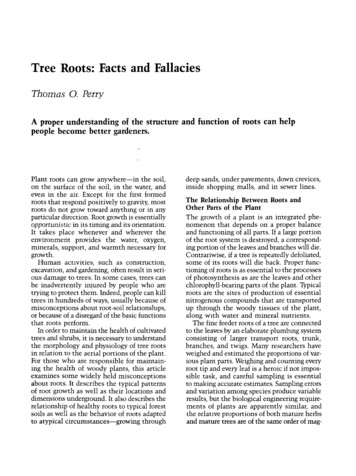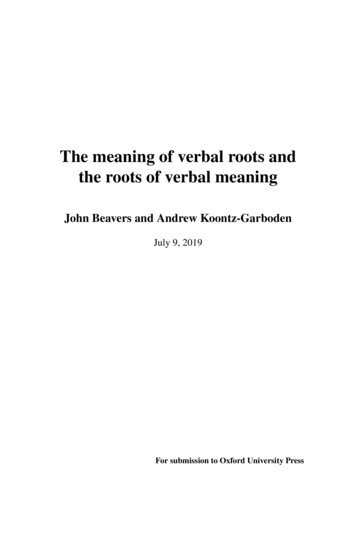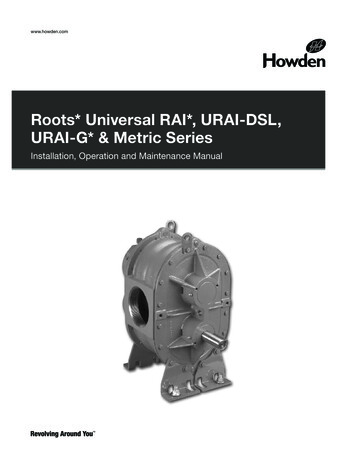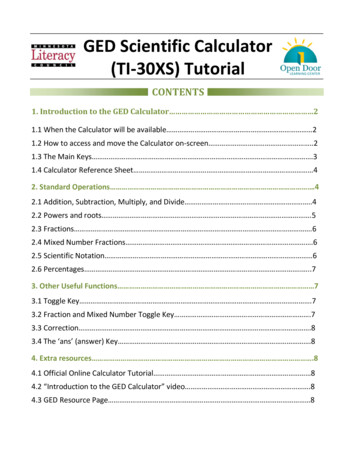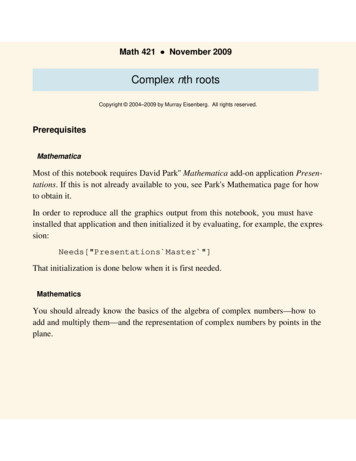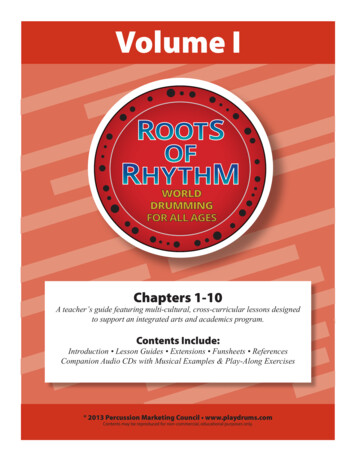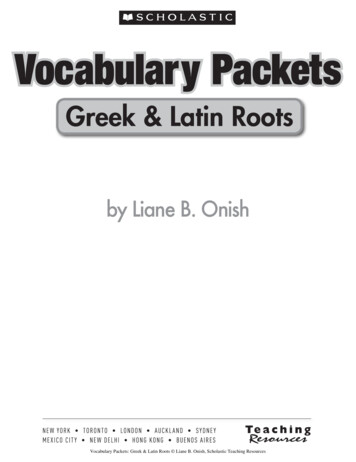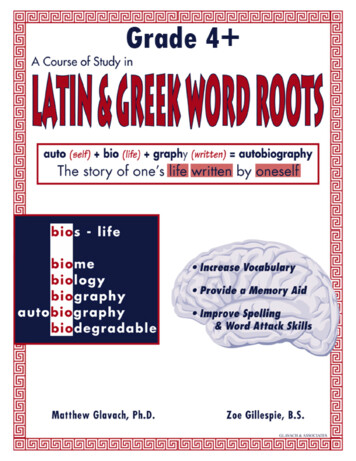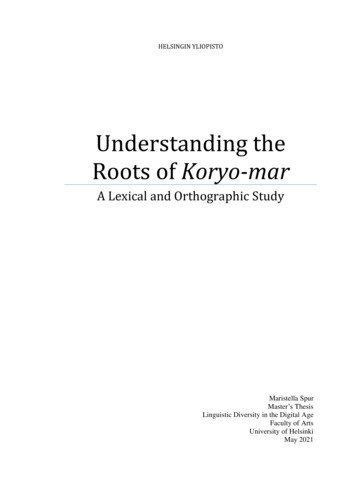
Transcription
HELSINGIN YLIOPISTOUnderstanding theRoots of Koryo-marA Lexical and Orthographic StudyMaristella SpurMaster’s ThesisLinguistic Diversity in the Digital AgeFaculty of ArtsUniversity of HelsinkiMay 2021
Tiedekunta – Fakultet – FacultyKoulutusohjelma – Utbildningsprogram – Degree ProgrammeFaculty of ArtsLinguistic Diversity in the Digital AgeOpintosuunta – Studieinriktning – Study TrackDiversity LinguisticsTekijä – Författare – AuthorSpur, MaristellaTyön nimi – Arbetets titel – TitleUnderstanding the Roots of Koryo-mar: A Lexical and Orthographic StudyTyön laji – Arbetets art – LevelMaster’s DegreeAika – Datum – Month andyearMay 2021Sivumäärä– Sidoantal – Number of pages58 11 (attachments)Tiivistelmä – Referat – AbstractThis thesis investigates the roots of Koryo-mar, an endangered language currently spoken by Koreandiaspora communities (also called Koryo-saram, lit. ‘Koryo-people’) in post-Soviet countries, such asKazakhstan and Uzbekistan, to which they had been deported in 1937 from the Russian Far East (RFE).By the end of the 19th century, the language of the first Korean immigrants to the RFE, for the most partpeasants from the Northeastern province of Hamgyŏng, had already caught the interest of a few scholars,among which can be distinguished Mikhail P. Pucillo, the author of the first Russian-Korean dictionary.Such volume, the Opyt Russko-Korejskogo Slovarja (1874) was based on the speech of the Koreans hewas in contact with, and represents one of the earliest sources for the study of Koryo-mar. On the otherhand, the actual research on the Koryo-saram begun in earnest only in the second half of the 20thcentury, and the work of Songmoo Kho, Koreans in Soviet Central Asia (1987), is often considered oneof the most complete surveys on the history and the culture of Central Asian Koreans. It also contains achapter devoted to Koryo-mar, that includes several wordlists of both native items and loanwords fromRussian and other local languages.By comparing the data extracted from the above-mentioned texts, on a lexical and orthographic level,and highlighting their similarities and variations, this research aims at illustrating the genetic tiesbetween the dialects of Northern Hamgyŏng and Koryo-mar, as well as the relationship between thespoken and the written language. Additional information has also been drawn from secondary sources inEarly Modern Korean, such as Hŏ Kyung’s Hong Kiltong Chŏn (16th-17th century), Chang Kyehyang’sŬmsik Timibang (1670s), and J. S. Gale’s translation of J. Bunyan’s The Pilgrim’s Progress (1895).The research concludes that the forty elements common to Pucillo (1874) and Kho (1987) can be framedinto five different relationship scenarios, which describe not only the continuation of lexical andorthographic material between the two texts and their languages, but also assess the latter’s connection toStandard Korean and its historical variants. Moreover, the examination of Pucillo’s usage of Cyrillic intranscribing Korean provides relevant details concerning the articulatory habits of Northeastern Koreansin the late 1800s, which are contextualised within and in contrast to the writing practices of EarlyModern Korean, that are known to be extremely inconsistent.This study, based on a philological approach, can aid in outlining a literary tradition that encompassesthe historical development of Koryo-mar, which is still an unrecognised minority language, while theanalysis of orthographic peculiarities can shed light on the chronology of the spread of certainphonological changes across the whole Korean peninsula.Avainsanat – Nyckelord – KeywordsKorean Language, Korean History, Philology, Koryo-mar, Language and Writing, Variation, Spelling,Orthography, Russian Far East, Central AsiaSäilytyspaikka – Förvaringställe – Where depositedHelsinki University Library – Helda / E-thesis: ethesis.helsinki.fiMuita tietoja – Övriga uppgifter – Additional information
iTable of Contents12Introduction . 41.1Previous Research . 41.2Structure and Aims . 61.3On Transliteration and Romanisation. 8Background . 92.12.1.1Periodisation of Chosŏn history . 102.1.2A Look at the Korean Peninsula . 122.1.3Koreans in the Russian Far East . 142.1.4Soviet Central Asian Koreans . 162.2Brief Chronology of Korean . 202.2.2Spelling and Standardisation . 212.2.3Dialects of North and South Korea . 242.2.4Koryo-mar and its Current State . 28Historical and Linguistic Timeline . 30Sources . 313.1Philology of Koryo-mar . 313.2Opyt Russko-Korejskogo Slovarja. 333.2.1Korean and Russian Orthography . 343.2.2Adapting the Cyrillic Script . 363.3Koreans in Soviet Central Asia . 363.3.1Wordlists and Dialectal Variation . 373.3.2Limitations . 393.44Linguistic Framework . 192.2.12.33Historical Origins of the Koryo-saram . 10Secondary Contrastive Sources . 39Data Analysis and Discussion . 41
ii4.1Data Collection . 414.2Data Comparison . 434.3Defining Cases and Correspondences . 454.3.1Pucillo (1874) and Kho (1987) . 454.3.2Pucillo (1874) and Standard Korean . 464.3.3Kho (1987) and Standard Korean . 484.3.4Correspondences Between All Three Sets . 494.3.5No Correspondences . 504.45Spelling and Spoken Language . 51Conclusions. 52List of References . 55Appendices . 59Appendix A: Romanisation of Korean . 59Table A.1: Vowels . 59Table A.2: Consonants . 60Appendix B: Cyrillisation of Korean . 61Table B.1: Consonants . 61Table B.2: Vowels . 62Table B.3: Additional Early Modern Korean Vowels . 63Appendix C . 64Table C.1: Animals . 64Table C.2: Body Parts . 64Table C.3: Food Terms . 65Table C.4: Human Terms . 66Table C.5: Miscellanea . 68Table C.6: Numerals . 69
iiiList of FiguresFig. 1 Map of the Eight Provinces of Korea. . 13Fig. 2 Major Dialect Areas of Korea . 25Fig. 3 Current Tone Distribution in Korea . 27Fig. 4 Pucillo (1874) - Opyt Russko-Korejskogo Slovarja . 34
41IntroductionIn the early 1860s, several waves of peasants from the province of Hamgyŏng,situated in the north-east of the Korean peninsula, moved and settled in the RussianFar East, as a response to “famines, hardship, a lack of social mobility, and the desirefor arable land” (Chang, 2016:9). Coming from a relatively poor and peripheralregion, these people would speak mostly Northeastern dialects typical of theirancestral hometowns, and it was their speech that was taken as the model for some ofthe earliest examples of Russian-Korean dictionaries, the first of which is M.Pucillo’s Opyt Russko-Korejskogo Slovarja (1874).Such language variants remained in use in their newly established communities,which increased in number and population steadily up to the late 1930s, when allKoreans were deported by the Soviet authorities under the suspicion that they mighthave had ties to the Japanese Empire and could possibly pose a threat to the wellbeing of the country. Forced to start a new life in countries like Kazakhstan,Uzbekistan, and Tajikistan, Koreans living in Soviet Central Asia began to callthemselves Koryo-saram (корё-сарам,their language became Koryo-mar (корё-мар,, meaning ‘Koryo people’) and, literally ‘Koryo language’).The present research focuses on two of the most relevant sources on Koryo-mar,Pucillo’s Opyt Russko-Korejskogo Slovarja (1874) and Kho’s Koreans in SovietCentral Asia (1987). Published over a hundred years apart from each other, theiranalysis and the comparison between the words contained in them allow for a betterunderstanding of Central Asian Korean and its development. Learning more aboutKoryo-mar and its characteristics from a diachronic perspective, moreover, can alsoshed light on lexical and phonological variation in Korean. In addition to that,looking at the way such vernacular has been recorded in texts can contribute to thestudy of the relationship between the spoken and the written language.1.1 Previous ResearchTalking about South and North Korea, Michael J. Seth (2016: 24) introduces a ratherinteresting question: “How is it possible that such a culturally and ethnically
5homogeneous people could have evolved so differently in seven decades?”. Suchmatter has been fascinating many scholars in contemporary Korean Studies, andextensive research on the differences between the two Koreas, on their historicaldevelopment following the end of WWII and the Korean War, and on North Koreandefectors in South Korea, is easily accessible. Moreover, there are other topics inKorean language and dialectology that seem to be more common and more wellresearched, such as the description and current state of Cheju language or thedifficulties of teaching Standard Korean to North Koreans defectors of different agegroups and social class.On the other hand, it is rather safe to say that there are only a handful of researcherswho have written extensively on the Koryo-saram communities living in ex-SovietCentral Asian countries (such as Kazakhstan, Uzbekistan, and Tajikistan), the mostwell-known being Songmoo Kho, German Kim, and Ross King.Songmoo Kho wrote one of the earliest and most complete studies on the history,culture, and language of Soviet Central Koreans, that is Koreans in Soviet CentralAsia (1987). A native of South Korea, his research was one of the first written bynon-Soviet scholars, and “the first of such length on the subject” (Genzor, 1991: 277).While not able to visit Central Asia to carry out fieldwork first-hand, his contactswith the Soviet Korean community allowed him to present new and usefulinformation on such little-known minority.German Kim, himself a Koryo-saram from Ushtobe (Kazakhstan), mainly aimed hisresearch at the study of the history of Korean communities in ex-Soviet countries,becoming the main Russian-language expert on the subject. He also collaboratedwith Ross King on several occasions: both were, for example, the guest editors of theKorean and Korean American Studies Bulletin vol. 12, nos. 2/3 2001, which focusedon Koreans in the Former USSR; more recently, they also co-authored the chapterThe Northern Region of Korea as Portrayed in Russian Sources, 1860s-1913 inSunjoo Kim’s The Northern Region of Korea: History, Identity, and Culture (2010).As for Ross King, he began establishing himself as the leading scholar in Koryo-marlinguistics in the last quarter of the 20th century, by publishing several relevantarticles (1987, 1988, 1991, 1992, 2006b) on the Soviet Korean grammar and North
6Korean dialectal materials. The most significant study of his, when it comes to thisresearch in particular, is An Introduction to Soviet Korean (1987), which iscontemporary to Kho’s above-mentioned monograph. In it, he outlined phonetic,phonological, morphological, and lexical features of Soviet Korean as collected byhim in Tashkent, further analysing them by making comparisons mainly withPucillo's Opyt Russko-Korejskogo Slovarja (1874), the Kazan materials (1904)1, andKim T’ae-Kyun’s Hambuk Pang’ŏn Sajŏn (1986). Eventually, he demonstrated thatKoryo-mar does not descend from a single variety of the North Hamgyŏng dialects,and highlighted the archaisms no longer found on the Korean peninsula.Taking such information into consideration, the present dissertation explores theextent to which it is possible to witness any known Koryo-mar features in the firstRussian-Korean dictionary, mainly through a comparison of the Korean vocabularyavailable in Pucillo (1874) and Kho (1987). Thus, the chronological direction of thisstudy is in contrast with the previous research: the focus is on how much of Koryomar can be seen already in the end of the 19th century, instead of on which older anddistinctive characteristics can be observed in the contemporary Central Asian Korean.1.2 Structure and AimsThe aim of this research is to examine the roots of Koryo-mar according to theprinciples of traditional philology, understood as the study of the historicaldevelopment of a language in written sources in connection to its literary and culturalcontext. In addition to the analysis of the contents of Pucillo’s Opyt RusskoKorejskogo Slovarja (1874) and the wordlists from Kho’s Koreans in Soviet CentralAsia (1987), further comparisons are done between the above-mentioned sources andto other Chosŏn-period texts chosen for their linguistic value.This process seeks to identify what traits typical of Koryo-mar were already evidentin the earlier stages of the language’s formation, and to distinguish the influence thatdifferent dialects (which could have had their roots beyond the borders of the NorthHamgyŏng province) might have had on it, rather than seeing which archaic features1The term Kazan materials is generally used to talk about two Russian sources on Korean, theRussko-Korejskie Razgovory (Russian-Korean Conversations) and the Opyt Kratkago RusskoKorejskago Slovarja (Attempt at a Short Russian-Korean Dictionary), that have been respectivelypublished in March and September 1904 by the Pravoslavnoe Missionerskoe Obscestvo, or OrthodoxMissionary Society (King, 1987: 239).
7were preserved in the most recent texts and speech. Moreover, this sort of analysisallows for a better understanding of Koryo-mar as a variant with its own cultural andhistorical identity, which is often overlooked in broad contemporary Korean studies.Given such premises, the main research questions to be discussed in this dissertationare the following: 1) What features of Koryo-mar can be traced back to the OpytRussko-Korejskogo Slovarja? 2) What kind of relationship is there between the NorthHamgyŏng dialects, Early Modern Korean as a whole, and Koryo-mar? 3) What canbe understood about the connection between the spoken and written language by thevernacular Korean orthography and Pucillo’s Cyrillisation?Although it is possible to define the historical circumstances that led to the creationof Korean communities in the Russian Far East and, later, in Central Asia,pinpointing the moment in which Koryo-mar started being a thing separate from theNortheastern dialects it is said to descend from is not as easy. With the aim ofshedding light on all such issues, Chapter 2 deals with both the historical andlinguistic background knowledge that can be gathered by examining the sociopolitical, cultural, and linguistic changes that the Korean peninsula went through,starting from the Chosŏn period (1392-1897) up to the deportation of the Koreans ofthe Russian Far East in the late 1930s.The sources that this work is based on and the methods here employed arethoroughly discussed in Chapter 3. The first subsection deals with the importance ofthe philological approach towards this study, as well as with what new information itcould bring when applied to a language such as Koryo-mar. It is followed by thedescriptions of the two primary sources, namely Mikhail Pavlovič Pucillo’s OpytRussko-Korejskogo Slovarja (1874) and Songmoo Kho’s Koreans in Soviet CentralAsia (1987), which represent two distinct points in the evolution the Soviet CentralAsian Korean: the former, in fact, is a Russian-Korean dictionary based on thespeech of informants from the North Hamgyŏng region, the first of its kind; the latter,as mentioned previously, contains valuable knowledge concerning the morecontemporary state of Koryo-saram communities and their speech. Lastly, other textsfrom the Late Chosŏn period, such as Chang Kyehyang’s Ŭmsik Timibang (ca. 1670),and James S. Gale’s 1895 translation of John Bunyan’s The Pilgrim’s Progress, are
8introduced as additional elements of comparison chosen to better understand thelexical and orthographical peculiarities of Koryo-mar.Chapter 4 pertains to the collection and the analysis of the data obtained fromprimary and secondary sources. Furthermore, it contains the discussion of the resultsof this philological study, as well as subsections dedicated to the different scenariosthat can be observed through the comparison of the various sources and to therelationship between spoken and written language. The conclusions, and a summaryof the whole thesis, are found in Chapter 5.While not directly belonging to the structure of this study, the appendices and theircontents are an integral part of the arguments here presented. Since both Cyrillic andHan’gŭl are used to write down Korean words in Pucillo (1874), Appendix Bincludes the correspondences between pre-standardisation Korean and theCyrillisation systems by Pucillo and Lev Rafailovič Koncevič, the latter being theone in current use. Appendix C, on the other hand, is a table containing all the datafrom the two primary sources examined and the equivalent Contemporary StandardKorean words.1.3 On Transliteration and RomanisationSince this research implies the comparison of data originally recorded in differentlanguages and writing systems, it is important to point out the approaches adopted torender each with the Latin alphabet. For what concerns terms in Russian, both in prerevolutionary and current orthography, the standards of the Scientific transliterationof Cyrillic are followed, except for х being rendered as kh . Such words includepersonal names, titles of books and papers, as well as items from the Opyt RusskoKorejskogo Slovarja (1874) that are mentioned both within the main body of the textand the appendices.As for Korean, it must be said that it is not at all unusual, in this field, to use twoseparate methods of Romanisation even in an individual paper for different reasons.In fact, Lee and Ramsey (2011: 10) state that “[n]o one system of romanization fitsevery purpose” and, in their joint work, chose to utilise both of the following: theMcCune-Reischauer Romanisation for general transliterations, as “usually judged[ ] to be esthetically pleasing, with a scholarly appearance on the page” and still
9considered “the academic standard in the Western world”; and, for linguisticinformation, Martin’s adaptation of the Yale method (1992), by them called “themost systematic and thoughtfully constructed transcription of earlier Korean”.Similarly, both the McCune-Reischauer and the Yale systems2 are employed in thisresearch: the former is made use of throughout the thesis, with possible modificationsdue to the presence of graphemes such asarae a, which has been rendered as ɒ3;on the other hand, the latter is found exclusively in Chapters 4, which concern theanalysis of the data and the discussion of the results, as the Yale Romanisationmethod allows for a bigger transparency of linguistic information by favouringunambiguous transliteration over easier pronunciation. Additionally, personal nameswithin the text and in the list of references are spelt according to individualpreferences, based on how they appear in the related sources.2BackgroundIt is undeniable that the contexts in which a language is born and used are extremelyrelevant, if not fundamental, to its own development and spread. Thus, in order tounderstand Koryo-saram and Koryo-mar in a more complete and well-rounded way,it is necessary to discuss the historical and linguistic circumstances that led to the riseof Korean diaspora communities in Soviet Central Asia and the differentiation oftheir language from that of their homeland.First, the focus is on the description of Chosŏn-period Korea and on the varioussocio-political issues that contributed to the migration of certain groups of the localpopulation beyond the national borders, and to the Russian Far East (thereafter calledRFE) in particular, during the second half of the 19th century. Then, topics such asthe Korean language, its chronology and standardisation, as well as its dialects, andKoryo-mar and its current state, are examined more in detail.2See the Romanisation of Korean tables in Appendix A, pp.59-60.Arae a is a grapheme that started being used with the promulgation of the Korean alphabet in the 15thcentury, but it disappeared from texts following the standardisation of Korean in the early 20th century.The value of the sound it corresponded to, which disappeared from the speech of Seoul around the18th century (Lee & Ramsey, 2011: 262), has been a matter of discussion between scholars fordecades, although it is generally analysed as either /ɔ/ or /ʌ/. Yet, arae a is still present in Chejulanguage as /ɒ/ (Yang, Yang, & O’Grady, 2019: 18) and, for this reason, the symbol has been adoptedin this study to represent a vowel otherwise absent in the McCune-Reischauer Romanisation system.3
102.1 Historical Origins of the Koryo-saramFor half a millennium, the Korean peninsula was ruled by the Yi dynasty, whose riseto power marked the beginning of what is called the Chosŏn period (1392-1897) andwhose demise was brought by the Japanese annexation of the country in 1910, afterthe establishment of the Korean Empire (1897-1910, Protectorate of Japan 19051910). Over these five-hundred years, the “land of Morning Calm” flourished withculture, literacy, self-sufficiency, and technological innovations, but also had to dealwith political unrest, wars, internal weakness, and the threat of multiple invasions upto the beginning of the 20th century.Since the history of the Koryo-saram began with the first migrations of Koreans tothe RFE in the second half of the 19th century, it is important to discuss the causes ofsuch diaspora and the general circumstances that the Kingdom of Chosŏn was goingthrough at the time. In particular, the first subchapter discusses the phases theChosŏn period is divided into and the events that influenced the latter’s development.Then, as Soviet Koreans mostly descend from peasants coming from the province ofHamgyŏng, a subsection of this chapter is also devoted to an overview of theregional divisions of the peninsula, and to the cultural and social differences betweenthe capital and the periphery. After these mainly introductory segments, attention ispaid to the relationships between Korea and the Russian Empire, and to the earlyKorean settlements in the RFE. Finally, the last subchapter deals with thecircumstances that led to the deportation of Koreans to Soviet Central Asia, as wellas with the role of Koryo-saram in the decades following their displacement.2.1.1Periodisation of Chosŏn historyIt is generally considered that the Chosŏn period consists of two main phases: EarlyChosŏn and Late Chosŏn, which are divided by the Imjin War (1592-1598). In fact,many of the achievements of the first two-hundred years seemed to have been erasedby the violence of the Japanese invasions led by Hideyoshi Toyotomi at the end ofthe 16th century, so much that even vernacular spelling started becoming moreirregular after the war. Alternatively, Pratt (2006: 116) talks about three periods: thefirst would be from 1392 until, again, the Imjin War; then, a “Middle Chosŏn” couldbe imagined to be spanning from the early 17th century up to the arrival of the
11Western powers in the 1800s; finally, the last period would cover the years before1910, which were characterised by internal conflicts as well as reforms aimedtowards the modernisation of the country.For the sake of this research, the first and most common periodisation is followed,and the Late Chosŏn period is considered to have lasted from the late 16th century tothe late 19th century. Such years were extremely important for the formation of thenation-states that occupy the Korean peninsula currently. Moreover, the threat ofWestern powers, which had been opening ports in the neighbouring China and Japanin the 1800s, further complicated the search for political stability and culturalindependence that had been a constant for a long time after the Imjin War (15921598) and the Manchu Invasion (1636-1637). The effect of these two historicalevents extended onto language usage as well, causing an increase in spellingvariation as described in Chapter 2.2.2.It was also in this context that the sobriquet “hermit kingdom”, now used frequentlyto describe North Korea, was first mentioned in response to the strong self-sufficientpolicies that were being employed to protect the country from possible foreigninfluence. Such was the policy of Taewŏn’gun (Yi Ha-Ŭng, 1820-1898, r. 18641873), whose regency came after two purges, in 1801 and 1839 respectively, and along power struggle among different clans for influence over the royal family. Theonly country allowed to trade with Chosŏn was the Qing Empire, but neither Westernmerchants nor Japan could engage in any commercial relations with the Koreanpeninsula. Furthermore, any foreigners that attempted to enter the Kingdom wouldeither be forcefully sent away, or outright challenged by the military, as in the case ofthe French Expedition to Korea (1866), the General Sherman Incident (1866), andthe United States Expedition to Korea (1871), up to the Treaty of Kanghwa Island(1876), which marked the opening of ports to the Japanese.At the same time, discontent was growing stronger among the lower classes and“popular disturbances broke out from time to time” (Seth, 2010: 217), mostly inresponse to increase in the price of certain produce, such as rice, or to unfair andsudden taxes. Riots occurred in Seoul in 1833, then called Hansŏng (or,meaning ‘Fortress on the Han River’), and several violent uprisings took place in theearly 1860s in the south of the peninsula. Meanwhile, in the northern regions,
12protests were also caused by local officials claiming to have been discriminatedagainst during state exams and in the appointment of both military and administrativeduties, compared to those who lived in the area of the kingdom’s capital.2.1.2A Look at the Korean PeninsulaBefore analysing the historical that led to the birth of the Koryo-saram community,some geographic and administrative remarks also need to be made. The position ofthe Korean peninsula has long been considered crucial in East Asia: sitting betweenQing China, Japan, and the Russian Empire, for most of Late Chosŏn, Korea wasused as a theatre of war by those external powers.With the beginning of the Chosŏn period, the kingdom was divided into eightprovinces (or, p’aldo ): P’yŏngan (,) and Hamgyŏng () in the northernmost part of the peninsula; then, Hwanghae (Kangwŏn (,region of Kyŏnggi () and Ch’ungch’ŏng (,); and Chŏlla (,,,),), surrounding the capital,) and Kyŏngsang (,) in the south. Despite its central position within the country, the city ofHansŏng and its inhabitants were often far removed from the issues of those wholived in the remote areas of both North and South, which were also the destination ofofficials and literati who were exiled from the capital itself. The divide between eachprovince, and between the central regions and the frontier ones, was furthermorestressed by the different local customs and dialects, the latter be
Tiedekunta - Fakultet - Faculty Faculty of Arts Koulutusohjelma - Utbildningsprogram - Degree Programme Linguistic Diversity in the Digital Age


